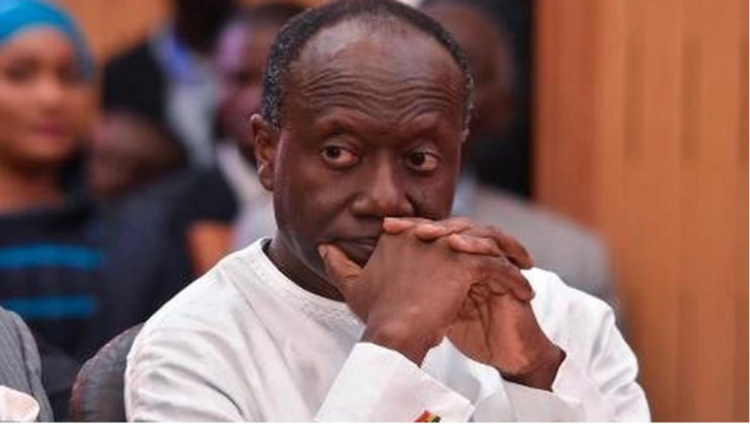
Audio By Carbonatix
Ghana’s total debt reached GH¢236.1 billion ending March this year, according to the latest Summary of Economic and Financial data released by the Bank of Ghana after its Monetary Policy Committee met to review developments in the economy over the past two months.
According to the data, the GH¢236.1 billion debt now sends Ghana’s Debt-to-GDP-Ratio to 59.3 per cent. Out of the total debt stock, $22.9 billion was external debt, which translates into 31.4 per cent of the total value of the economy, while GH¢111.3 billion was secured locally representing 28 per cent of the total value of the economy.
Also, out of the total debt stock, GH¢1.8 billion has been spent on the financial sector clean so far for the first three months of this year.
Rate of increase over the past year
Based on the summary of the financial and economic data, Ghana’s total debt stock has gone up by GH¢18 billion since December 2019. However, tracking the debt position from March 2019 to March 2020, the total debt stock has gone up by GH¢38.1 billion.
Reasons for the hike in Debt stock
The increase in the debt stock from December 2019 to March 2020 can be attributed to the cedi’s marginal depreciation and recent funds advanced towards the cleanup of the banking and non-banking sectors of the economy. The data showed that from December 2019 to March 2020 the total debt stock went up by GH¢38. 1 billion.
How much does every Ghanaian owe?
Based on the GH¢236.1 billion debt, every Ghanaian should owe about GH¢ 7, 870 if the debt is shared among the population size of 30 million.
Impact of rising debt stock on the economy
For some, the impact would be on Ghana’s debt servicing bill. According to the 2020 Budget government was planning to set aside GH¢21.7 billion just to pay for the interest of funds borrowed.
However other sectors performed?
The data showed that total earnings from exports stood at $3.9 billion ending March this year, compared to a little over $4 billion realized in the period for last year.
Gold for the first three months of this year brought in $1.4 billion compared to a similar amount for the same period for last year. Cocoa got us $956 million for the first quarter of 2020, compared to the $832 million secured in the first quarter of 2019.
Earnings from oil stand at $874.1 million for the first quarter of 2020 compared to a little over $1 billion in 2019. On the other hand, total imports for the first quarter stood $2.9 billion, compared to $3.3 billion for the same period in 2019.
Total non-oil imports stood at $2.4 billion for the first quarter of 2020 compared to $2.6 billion secured in the same period for 2019. This resulted in a trade balance of $934 million, compared to $642 million for the same period for 2019.
This resulted in a trade balance of $936 million, representing 1.4 per cent of GDP.
The country’s Gross International Reserve ending March this year stood at $10.2 billion. This should translate into 4.8 months of import cover.
Banking Sector Developments
The data also revealed that the Non-Performing Loans reduced from 18.8 per cent in March 2019 to 14.5 per cent in March 2020.
Total assets stood at GH¢113 billion ending March from GH¢111 billion in March 2019. Total Banking Deposits was GH¢85 billion up by 15.1 per cent from the same period last year, while total advances went up by 16.5 per cent to reach GH¢51.9 billion.
Latest Stories
-
Adom FM’s ‘Strictly Highlife’ lights up La Palm with rhythm and nostalgia in unforgettable experience
2 hours -
Ghana is rising again – Mahama declares
5 hours -
Firefighters subdue blaze at Accra’s Tudu, officials warn of busy fire season ahead
6 hours -
Luv FM’s Family Party In The Park ends in grand style at Rattray park
6 hours -
Mahama targets digital schools, universal healthcare, and food self-sufficiency in 2026
6 hours -
Ghana’s global image boosted by our world-acclaimed reset agenda – Mahama
6 hours -
Full text: Mahama’s New Year message to the nation
6 hours -
The foundation is laid; now we accelerate and expand in 2026 – Mahama
7 hours -
There is no NPP, CPP nor NDC Ghana, only one Ghana – Mahama
7 hours -
Eduwatch praises education financing gains but warns delays, teacher gaps could derail reforms
7 hours -
Kusaal Wikimedians take local language online in 14-day digital campaign
8 hours -
Stop interfering in each other’s roles – Bole-Bamboi MP appeals to traditional rulers for peace
8 hours -
Playback: President Mahama addresses the nation in New Year message
8 hours -
Industrial and Commercial Workers’ Union call for strong work ethics, economic participation in 2026 new year message
10 hours -
Crossover Joy: Churches in Ghana welcome 2026 with fire and faith
10 hours

